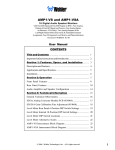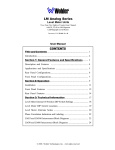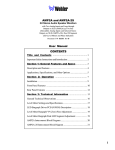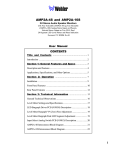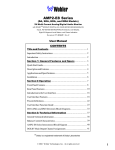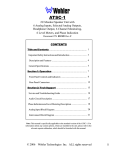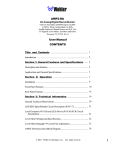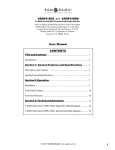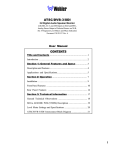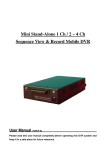Download Wohler VMDA-1 User manual
Transcript
VMDA Series (VMDA-1 and VMDA-4) 1U Monitor Speaker Unit with 1 or 4 AES/EBU Digital Inputs, 1 or 4 Analog Stereo Inputs, Selected Analog Outputs, Speaker Muting, Headphone Output, Phase Indication, and Level Meters Document P/N 821115 Rev-D User Manual CONTENTS Title and Contents ........................................................... 1 Important Safety Instructions and Introduction ............................ 2 Installation .................................................................................. 3 Description and Features ........................................................... 4 General Specifications ............................................................... 5 Section 1: Operation ...................................................... 7 Front Panel Controls and Indicators ........................................... 8 Rear Panel Connectors and Settings ............................................ 12 Section 2: Technical Information ............................. 15 Service and Troubleshooting Guide ............................................ 16 Main PCB Circuit Description .................................................... 16 VMDA-1 and VMDA-4 Block Diagrams ................................... 18 VMDA Series User Manual P/N 821115 Rev-C.5 Important Safety Instructions 1) Read these instructions. 2) Keep these instructions. 3) Heed all warnings. 4) Follow all instructions. 5) Do not use this apparatus near water. 6) Clean only with dry cloth. 7) Do not block any ventilation openings. Install in accordance with the manufacturer's instructions. 8) Do not install near any heat source such as radiators, heat registers, stoves, or other apparatus (including amplifiers) that produce heat. 9) Do not defeat the safety purpose of the polarized or grounding-type plug. A polarized plug has two blades with one wider than the other. A grounding type plug has two blades and a third grounding prong. The wide blade or the third prong are provided for your safety. If the provided plug does not fit into your outlet, consult an electrician for replacement of the obsolete outlet. 10) Protect the power cord from being walked on or pinched, particularly at plugs convenience receptacles and the point where they exit from the apparatus. 11) Only use attachments/accessories specified by the manufacturer. 12) Use only with the cart stand, tripod, bracket, or table specified by the manufacturer, or sold with the apparatus. When a cart is used, use caution when moving the cart/apparatus combination to avoid injury from tip-over. 13) Unplug this apparatus during lightning storms or when unused for long periods of time. 14) Refer all servicing to qualified service personnel. Servicing is required when the apparatus has been damaged in any way, such as when power-supply cord or plug is damaged, liquid has been spilled or objects have fallen into the apparatus, the apparatus has been exposed to rain or moisture, does not operate normally, or has been dropped. 15) Do not expose this apparatus to rain or moisture. 16) The apparatus shall be connected to a mains socket outlet with a protective earthing connection. CAUTION! In products featuring an audio amplifier and speakers, the surface at the side of the unit, where the audio amplifier heat sink is internally attached, may get very hot after extended operation. When operating the unit excercise caution when touching this surface and ensure that external materials which may be adversely affected by heat are not in contact with it. There is a Hot Surface label (see diagram) attached to the aforementioned surface of the product. Introduction Congratulations on your selection of a Wohler Technologies VMDA Series audio monitor unit. We are confident it represents the best performance and value available, and we guarantee your satisfaction with it. If you have questions or comments you may contact us at: Wohler Inc. WohlerTechnologies, Technologies, Inc. 31055 Huntwood Avenue 31055 Huntwood Avenue Hayward, CA 94544 Hayward, CA 94544 Phone: (510) 870-0811 Phone: (510)870-0810 589-5676 Fax: Fax: (510) (510) 870-0811 US USToll-Free: Toll-Free: 1-888-596-4537 1-888-596-4537 web: www.wohler.com [email protected] e-mail: [email protected] www.wohler.com 2 © 2006 Wohler Technologies Inc. ALL rights reserved VMDA Series User Manual P/N 821115 Rev-C.5 INSTALLATION Mounting The unit should be mounted where convenient for operating persons, ideally at approximately ear level for best high frequency response. Its superior magnetic shielding eliminates concerns about locating it adjacent to most types of CRT monitors, including even high-resolution color monitors. Heat Dissipation Heat dissipated by the speaker amps is conducted directly to the left side of the chassis; no special considerations for cooling are necessary as long as the ambient temperature inside the rack area does not exceed approximately 40°C (104°F). Sympathetic Vibration Sympathetic vibration from other equipment (cables, etc.), in the rack may be serious enough to interfere with the unit’s sound quality out in the listening area. The use of thin card stock and/or felt or foam weather-stripping type materials between adjacent vibrating surfaces, or tying up loose cables, etc., may be required to stop vibrations external to the unit. Mechanical Bracing Even though the unit is fairly heavy, the chassis is securely attached to the front panel at eight points along its surface, not just at the four corners of the chassis ears. This feature will reduce or eliminate rear bracing requirements in many mobile/portable applications. The weight of internal components is distributed fairly evenly around the unit. Audio Connections Connection of the audio feeds is straightforward. The system block diagram located on pages 20 and 21 may be referred to for clarification of the general signal paths into and out of the VMDA unit. Electrical Interference As with any audio equipment, maximum immunity from electrical interference requires the use of shielded cable. However, satisfactory results can sometimes be obtained without it. The internal circuitry common is connected to the chassis. Unbalanced sources may also be applied to the balanced inputs. The gain is 6 dB greater with a single-ended source connected across both “hot” terminals than when connected between either input and common. Note that the unused input terminal of a balanced input should be connected to common, rather than being left floating, to insure best immunity to noise. AC Power The unit's AC mains connection is via a standard IEC inlet, with safety ground connected directly to the unit's chassis. The universal AC input (100-240VAC, 50/60Hz) switching power supply is a self-resetting sealed type, with automatic over-voltage and over-current shutdown . There is no user-replaceable fuse in either the primary or secondary circuit. © 2006 Wohler Technologies Inc. ALL rights reserved 3 VMDA Series User Manual P/N 821115 Rev-C.5 713 Grandview Drive, South San Francisco,CA 94080 650 589-5676 Fax +1 650 589-1355 VMDA Series "Confidence Plus" Audio Monitors Featuring Models: VMDA-1 and VMDA-4 WOHLER TECHNOLOGIES FAST-IN POWER 3 2 1 0 1 3 5 7 10 20 3 2 1 0 1 3 5 7 10 20 AVG O FAST-OUT ANALOG VMDA-1 DIGITAL MUTE TAP TO MUTE (BLINKS) HOLD 1 SEC TO CHANGE A/D VMDA-1 Front Panel 1 3 2 1 0 1 3 5 7 10 20 WOHLER TECHNOLOGIES 3 2 FAST-IN POWER 3 2 1 0 1 3 5 7 10 20 4 AVG O FAST-OUT ANALOG VMDA-4 DIGITAL MUTE TAP TO MUTE (BLINKS) HOLD 1 SEC TO CHANGE A/D VMDA-4 Front Panel Description The single-rackspace VMDA series monitors permit selectable monitoring of from one to four stereo analog or four AES audio sources, with excellent full-range fidelity far exceeding that of an ordinary monitor. The VMDA-1 monitors one stereo analog or AES audio source while the VMDA-4 can monitor up to four stereo analog or AES audio sources. In the VMDA-4, individual lighted push buttons select and indicate which of the four sources is being monitored. Two or more pairs of the analog inputs may be summed (as pairs) by pressing the desired buttons simultaneously (note that AES inputs cannot be summed). A separate lighted push button switches between the selected analog or digital source(s). In the VMDA series, two front-firing midrange-tweeter speakers and a compact high-performance woofer are arranged in Wohler Technologies popular bi-amp design. The summed bass feature is important for audible detection of “out of phase” conditions. Speaker amp limiters prevent accidental damage to speakers from high input levels. Volume and Balance controls are standard, but can be reconfigured as A volume/B volume via an internal jumper. A front panel mute function is engaged by tapping the Analog/Digital selector button briefly. The button’s light blinks while speakers are muted. Muting may also be activated from a switch remoted from the rear panel. The VMDA series also features 10-segment LED bargaph meters that provide visual indication of input levels. Fast and averaging “phase” LEDs gives visual alert of “out of phase” conditions, and indicate whether the source is stereo or mono. An auxilliary analog output of the selected analog or digital source is provided on the rear panel. The VMDA series is completely magnetically shielded to allow interference-free operation immediately adjacent to all CRT video monitors. Its lighter weight and shallower-depth chassis (compared to similar-type units) make it ideal for use in portable and mobile vehicle applications. Features • Selectable monitoring of one of four stereo analog or four AES channels in one unit • Headphone jack w/ speaker muting • Analog channel pairs may be summed • Only ONE rack space high, but produces a powerful 96 dB • Balanced and Unbalanced AES inputs SPL @ 2 feet • Balanced stereo analog output of selected source • Blowout-proof speakers • Lightweight and shallow-depth chassis • Volume/Balance controls are standard, jumper-configurable as A-volume/B-volume • Internal universal AC mains power supply • Thoroughly magnetically shielded • Front panel and remote-control speaker muting • LED level meters and ”Phase” indication LEDs 4 © 2006 Wohler Technologies Inc. ALL rights reserved VMDA Series User Manual P/N 821115 Rev-C.5 Applications Radio: Monitoring multiple incoming feeds for news /talk shows Television/Video Post: Confidence/cueing monitoring for D2- , D3- and D5-type VTRs in machine rooms and edit bays • Monitoring of multiple inputs in TV newsrooms Commercial industrial Sound: Monitoring multiple audio feeds in theme parks, security installations, and teleconferencing systems General Specifications Analog input impedance: >100k Ohms balanced AES/EBU input: 75 and 110 ohms term, selectable Digital Input sampling rate: 32-48 kHz, auto-sensing Input level for full output (volume full on): 0 dBv balanced (analog) 20 dBfs (digital) Hum and noise: Better than -70 dB below full output Acoustic frequency response: 60 Hz to 16 kHz (± 6dB) Maximum acoustic output: 96 dB SPL at 2 feet Electrical distortion: (speaker outputs) Less than 0.3% at any level below limiting threshold Acoustic distortion: Typically < 2% at any level below limiting, 100 Hz-15 KHz Magnetic shielding: Less than 0.2 Gauss any adjacent surface Connectors: Balanced: “mini” Phoenix 3.5mm Unbalanced: BNC Chassis Dimensions (HxWxD): 1.75 x 19 x 9.0 in. (44.5 x 483 x 246 mm.) Weight: 6.8 lbs. (3.1kg) Power Supply: Universal AC input (100-240V) UL/ CSA approved Typical Audio Response Curve +10 0 d B -10 -20 -30 20 50 100 200 500 1k 2k 5k 10k 20k Hz Typical 1/6 Octave Audio Response Curve Units are certified to meet, at time of manufacture, all currently applicable product safety and EMC requirements, such as those of UL and CE. 0 dbV ref. 0.775V RMS. Features and specifications subject to improvement without notice. © 2006 Wohler Technologies Inc. ALL rights reserved 5 VMDA Series User Manual P/N 821115 Rev-C.5 (This page left intentionally blank) 6 © 2006 Wohler Technologies Inc. ALL rights reserved VMDA Series User Manual P/N 821115 Rev-C.5 Section 1: Operation Front Panel Controls and Indicators Rear Panel Connectors and Settings © 2006 Wohler Technologies Inc. ALL rights reserved 7 VMDA Series User Manual P/N 821115 Rev-C.5 FRONT PANEL CONTROLS AND INDICATORS Please refer to Figure-1a on the following page to familiarize yourself with the front panel controls and indicators of the VMDA series units. The following sections describe the functions of each of the various controls and indicators found on the front panel and are referenced, by number, to Figure-1a. 1 Speakers The VMDA series internal speaker system is comprised of two mid-range tweeter speakers (left and right) and one compact woofer speaker (center). Speaker amp limiters prevent accidental damage to the speakers due to excessive input levels. 2 Volume Control This controls the loudness of the audio reproduced by the internal speakers or connected headphone. 3 Audio Level Bargraph Meter Displays Audio levels for the selected source channels are displayed via two 10-segment LED bargraph meters (one on the left side of the front panel; one on the right side). Dynamic range for these meters is 23dB. Contact the factory for additional meter information concerning meter scales and ballistics. 4 Channel Select Buttons (VMDA-4 Only) These four buttons select which channel(s) will be monitored through the speakers and are labled 1 through 4. When monitoring analog signals it is possible to monitor from one to four stereo pairs. When monitoring two, three, or four analog stereo pairs, the channel pairs are summed together and are reproduced simultaneously from the left and right speakers. However, when monitoring digital signals, only one stereo pair at a time may be monitored. An LED in each button lights up to indicate which channel(s) are selected for monitoring. 5 Headphone Jack For critical listening or for listening in high noise environments, use the headphone feature rather than the internal speakers. Select the headphone audio sources as you would for the internal speakers. When you plug in headphones, the internal or external speakers will mute. This jack accepts the standard 1/4” phone type stereo plug. 6 Power Indicator LED The Power Indication LED signals the operating condition of the power supply. The LED glows green to indicate the unit is connected to mains power and an operation voltage is present. 7 Balance Control This pans the volume balance between the left and right speakers. 8 Input Select / Speaker Mute Button This button serves a dual function; it selects between the two input signal types (digital AES/EBU or analog) and also toggles the speaker mute feature on and off. Source Select: The button exhibits a steady green glow to indicate that the unit is monitoring the digital inputs and the button is unlit when indicating that the unit is monitoring the analog inputs. To toggle between the digital and analog source types, the button is depressed for one second. Mute: To mute the speakers at any time, the button is briefly tapped once, the button blinks to indicate it is in mute mode. A second single tap unmutes the speakers. (Continued) 8 © 2006 Wohler Technologies Inc. ALL rights reserved VMDA Series User Manual P/N 821115 Rev-C.5 WOHLER TECHNOLOGIES WOHLER TECHNOLOGIES 1 1 2 2 3 3 3 2 1 0 1 3 5 7 10 20 3 2 1 0 1 3 5 7 10 20 1 3 4 2 4 POWER 5 POWER 5 6 6 1 1 7 7 3 3 3 2 1 0 1 3 5 7 10 20 3 2 1 0 1 3 5 7 10 20 8 8 AVG O FAST-IN FAST-OUT MUTE DIGITAL 1 1 VMDA-4 VMDA-1 9 © 2006 Wohler Technologies Inc. ALL rights reserved ANALOG 9 TAP TO MUTE (BLINKS) HOLD 1 SEC TO CHANGE A/D AVG O FAST-IN FAST-OUT MUTE DIGITAL ANALOG TAP TO MUTE (BLINKS) HOLD 1 SEC TO CHANGE A/D 9 VMDA-4 Front Panel VMDA-1 Front Panel Figure 1a.- VMDA Front Panel Controls and Indicators VMDA Series User Manual P/N 821115 Rev-C.5 FRONT PANEL CONTROLS AND INDICATORS (Cont.) 9 Phase Indication LEDs The phase indication LEDs offer immediate verification of phase (polarity) relationships in stereo or mono sources. There are three LEDs; the two smaller LEDs on top and bottom show instantaneous (fast) phase relationships in the signal, while the center (and larger) LED will indicate the average phase condition. The small top, or in-phase, LED (FAST-IN) glows (or blinks) green when signals are in phase. The small bottom , or out-of-phase, LED (FAST-OUT) glows (or blinks) amber for out of phase signals. The large center LED (AVG) indicates the average phase condition by glowing green for in-phase conditions, or red for out-of-phase conditions. In general, it is sufficient to regard the center LED (average phase condition) as adequate for proper phase monitoring. While it is normal for stereo signals to contain some intermittant instanateous out-of-phase and inphase conditions (small LEDs), a steady red glow of the larger center LED almost always indicates an out-ofphase alarm condition. (Continued) 10 © 2006 Wohler Technologies Inc. ALL rights reserved VMDA Series User Manual P/N 821115 Rev-C.5 WOHLER TECHNOLOGIES WOHLER TECHNOLOGIES 1 1 2 2 3 3 3 2 1 0 1 3 5 7 10 20 3 2 1 0 1 3 5 7 10 20 2 4 POWER 5 6 6 1 1 7 7 3 3 3 2 1 0 1 3 5 7 10 20 3 2 1 0 1 3 5 7 10 20 8 8 AVG O FAST-IN FAST-OUT MUTE DIGITAL ANALOG 9 TAP TO MUTE (BLINKS) HOLD 1 SEC TO CHANGE A/D AVG O FAST-IN FAST-OUT MUTE DIGITAL ANALOG TAP TO MUTE (BLINKS) HOLD 1 SEC TO CHANGE A/D 9 1 1 VMDA-4 VMDA-1 11 © 2006 Wohler Technologies Inc. ALL rights reserved 1 3 4 POWER 5 VMDA-4 Front Panel VMDA-1 Front Panel Figure 1a.- VMDA Front Panel Controls and Indicators VMDA Series User Manual P/N 821115 Rev-C.5 REAR PANEL CONNECTORS AND SETTINGS Please refer to Figure-1b on the following page to familiarize yourself with the rear panel connectors and settings of the VMDA series units. The following sections describe the functions of each of the various connectors and settings found on the rear panel and are referenced, by letter, to Figure-1b. A Power Connector Attach a standard IEC-320 power cord between this connector and mains power (100 - 240VAC nominal, 50/ 60 Hz). The front panel power LED will glow green to indicate an operating voltage is present. B Analog Output (Left and Right) - Phoenix (Mini-Combicon) Connector This Phoenix style, Mini-Combicon, dual vertical, 6-position terminal block connector outputs the currently selected left and right channels as monitored from the left and right speakers (or headphone). The top three positions are the left output; bottom three positions are the right output. C AES Inputs (1 - 4) - Phoenix (Mini-Combicon) Connectors VMDA-4: These Phoenix style, Mini-Combicon, dual vertical, 6-position terminal block connectors receive standard AES/EBU digital signals. There are a total of four (4) inputs; two on the first connector and two on the second connector, and are labeled AES 1, AES 2, AES 3, and AES 4. VMDA-1: This Phoenix style, Mini-Combicon, 3-position terminal block connector receives standard AES/ EBU digital signals. There is one of these inputs, labeled AES 1. This mini-Phoenix connector is configured as a 110 Ohm balanced input. D AES Inputs (1 - 4) - BNC Connectors VMDA-4: These panel mounted BNC connectors receive standard AES/EBU digital signals. There are a total of four (4) inputs. Inputs are labeled AES 1, AES 2, AES 3, and AES 4. These BNC connectors are configured as 75 Ohm unbalanced inputs. VMDA-1: This panel mounted BNC connector receives standard AES/EBU digital signals. There is one input, labeled AES 1. This BNC connector is configured as a 75 Ohm unbalanced input. E Termination Settings for AES Inputs - DIP Switch Modules These DIP switches set the termination characteristics of the AES/EBU inputs. In the event that signals entering the AES Inputs 1, 2, 3, and/or 4 are chained to other equipment that come after the VMDA unit, then the respective DIP switch should be set to “unterminated”. If there is no signal chaining after the VMDA, then the respective DIP switch should be set to “terminated”. VMDA-4: There are two DIP switch modules; one for the AES 1 and AES 2 termination settings, and a second DIP switch module for the AES 3 and AES 4 termination settings. Each DIP switch has two sections (switches), which set the termination for the associated input; Term. 1 for AES 1, Term. 2 for AES 2, Term. 3 for AES 3, and Term. 4 for AES 4. The switches are set in the down position for terminated and up for unterminated. VMDA-1: There is only one DIP switch module with one active section (switch), which sets the termination for the single AES input. Use the section on the left of the DIP switch module (the one on the right is not used). The switch is set in the down position for terminated and up for unterminated. F Analog Inputs (1 - 4) - Phoenix (Mini-Combicon) Connectors These Phoenix style, Mini-Combicon, dual vertical, 6-position terminal block connectors receive standard analog stereo signals. On the VMDA-4, there are a total of four (4) connectors while on the VMDA-1 there is one connector. Each connector has two inputs, with three positions per input. For each connector, the top three positions are the left input; the bottom three positions are the right input. These mini-Phoenix connectors are configured as 110 Ohm balanced inputs. 12 © 2006 Wohler Technologies Inc. ALL rights reserved VMDA Series User Manual P/N 821115 Rev-C.5 100-240 VAC 50/60 Hz 50/60 Hz A 100-240 VAC A VMDA-4 253589 VMDA-1 253582 AES 2 AES 2 TERM. 2 AES 4 AES 3 ANALOG OUTPUT TERM. 1 AES 1 AES 1 C AES 1 TERM. D E D C B ANALOG AES 1 C D E TERM. 3 AES 3 AES 4 TERM. 4 D E D 1 F 3 4 HI LO ANALOG INPUT 2 HI LO F RIGHT LEFT ANALOG INPUT HI LO LEFT RIGHT 13 © 2006 Wohler Technologies Inc. ALL rights reserved LEFT RIGHT LEFT RIGHT HI LO B VMDA-4 Front Panel VMDA-1 Front Panel HI LO HI LO HI LO HI LO HI LO HI LO Figure-1b. VMDA Rear Panel Connectors and Settings VMDA Series User Manual P/N 821115 Rev-C.5 (This page left intentionally blank) 14 © 2006 Wohler Technologies Inc. ALL rights reserved VMDA Series User Manual P/N 821115 Rev-C.5 Section 2: Technical Information Service and Toubleshooting Guide Audio Circuit Description Interconnect Block Diagram © 2006 Wohler Technologies Inc. ALL rights reserved 15 VMDA Series User Manual P/N 821115 Rev-C.5 SERVICE AND TROUBLESHOOTING GUIDE General Mechanical Observations Elimination of cabinet and component sympathetic vibrations (resonances) requires considerable attention to mechanical details. Because of this, and the physical constraints of the speaker’s acoustic enclosures, even minor changes to any of the mechanical details of the unit can seriously impair its acoustic performance. This especially applies to the speaker baffles. If mechanical work on the unit is necessary, be sure to make adequate notes to permit accurate reassembly. Unfortunately, the unusual and wholly proprietary method of magnetic shielding is usually degraded slightly by any disassembly of the unit, except removal of the rear panel. Almost any maintenance or repair will require removal of the cover. If an immediately adjacent video monitor shows magnetic interference after reassembly of the unit, it must be returned to the factory to restore the shielding completely. Level Adjustment The VMDA is set at the factory for a nominal digital line level of +20 dBFS and a nominal analog line level of +4 dBU. Other line levels require either a custom order or require that the customer adjust the unit. To adjust the unit for the first time, apply a digital signal (test-tone) of the nominal line level. Adjust the trim pots P5 and P8 so that the balanced analog out output is at the nominal analog line level. Apply a balanced analog signal of the nominal line level, select that signal for monitoring, then adjust the trim pot P2 and P3 until the balanced analog output is at the same level as the balanced analog input. Then adjust the trim pots P6 and P7 so that the front panel bargraph meters read zero level. MAIN PCB (719141) CIRCUIT DESCRIPTION The Controller IC15 (PIC16C74B) is an 8-bit CMOS micro-controller with an on chip A/D converter. This chip controls nearly all the functions of the VMDA unit. 1) IC15 reads the position of the volume and balance potentiometers, on pins 2 and 3, and issues commands to the codec (IC20) via the serial control buss to set the audio level accordingly. 2) IC15 reads the level of the signal going to the speaker amplifiers (IC1 and IC3). If this signal is so large that it may damage the speakers it issues commands to the codec to limit the audio level. The level of the signal for the right speaker is read off pin 4, the level of the signal for the left speaker is read off pin 5, and the level of the signal for the center bass speaker is read off pin 7. 3) IC15 reads the signal of the right and left channels on pins 8 and 9. It calculates the phase difference between the two channels and lights the phase indicators LED’s accordingly. The phase indicator LED’s; LED1, LED2 and LED3, are powered through pins 19, 20, 21 and 22. 4) IC15 controls an analog switch (IC22), which is used to prevent audio transients, that occurs when the codec changes input channels, from reaching the speakers or the analog output. The logic level output of pin 17 of IC15 is translated to the level required to control the analog switch (IC22) by the transistor Q4. 5) IC15 can reset the codec by toggling pin 16. The codec is controlled by IC15’s serial port. The serial control lines are on pins 15, 18, 23 and 24. (Continued) 16 © 2006 Wohler Technologies Inc. ALL rights reserved VMDA Series User Manual P/N 821115 Rev-C.5 MAIN PCB (719141) CIRCUIT DESCRIPTION (Cont.) 6) IC15 selects which analog channels are monitored by setting the control lines ACH1, ACH2, ACH3 and ACH4 (pins 30, 29, 28 and 27). . The logic level output of IC15 is translated to the level required to control the analog switches (IC4, IC5, IC6, IC7, IC10 and IC11) by the quad op amp IC14. 7) IC15 reads the push buttons on the front panel and lights the LED’s inside of these buttons. These buttons are connected to the following pins; pin 36 is the channel 1 button, pin 35 is the channel 2 button, pin 33 is the channel 3 button and pin 34 is the channel 4 button. The analog/digital/mute switch is connected to pin 37. 8) IC15 reads the state of the headphone sense line (pin 39). If a headphone is inserted into the ¼” jack on the front panel IC15 will mute the speaker amplifiers (IC1 and IC3). The logic level output of IC15 is translated to the level required to mute the speaker amplifiers by the transistor Q2. 9) IC15 presently does not use pins 10, 25, 26 and 40. The Codec IC20 is a Crystal Semiconductor CS4226 codec. It has a stereo 20-bit A/D converter, six 20-bit D/A converters and a S/PDIF receiver. Each of the six D/A outputs has an independent volume control. 1) IC20 has four digital audio input signals on pins 1, 42, 43 and 44. These signals either come from the BNC’s on the rear panel (J7, J6, J9 and J10) or the mini-terminal block connectors (J8 and J11). The BNC’s accept 75 ohm unbalanced digital audio. The mini-terminal block connectors accept 110 ohm balanced digital audio. The 110 ohm balanced digital audio signal is converted to 75 ohm unbalanced digital audio signals by the transformers T1, T2, T3 and T4. These digital audio signals can be terminated by the user by closing the appropriate section the DIP switches S1 and S2. IC15 controls which digital audio signal is selected by means of the serial control buss (pins 3, 4, 5 and 6). 2) IC20 has a balanced analog audio signal on pins 10, 11, 12 and 13. This signal comes from the analog input select circuitry. 3) IC20 has six signal ended analog outputs. AOUT1 and AOUT2 (pins 21 and 22) are summed, sent through a low pass filter (IC18) and then to the center speaker amplifier (IC3). AOUT3 and AOUT4 (pins 23 and 24) are filtered to reject out of band noise (IC23), sent through a high pass filter (IC21) and then to the side speaker amplifiers (IC1). AOUT5 and AOUT6 (pins 25 and 26) are filtered to reject out of band noise (IC26) and then sent to the balanced audio output (IC24 and IC28). Analog Input Select Circuitry Balanced analog audio signals are connected to the unit via the mini-terminal block connectors J2, J3, J4 and J5. This signal passes though the analog switches (IC4, IC5, IC6, IC7, IC10 and IC11). The left side of the selected channels are summed together by IC8. The right side of the selected channels are summed together by IC12. The potentiometers P2 and P3 are used to adjust the signal to the correct level for the codec (IC20). Refer to the interconnect block diagrams on he following pages, for assistance in tracing the signal path through the detailed schematic. © 2006 Wohler Technologies Inc. ALL rights reserved 17 VMDA Series User Manual P/N 821115 Rev-C.5 VMDA-1 Block Diagram 18 © 2006 Wohler Technologies Inc. ALL rights reserved VMDA Series User Manual P/N 821115 Rev-C.5 VMDA-4 Block Diagram © 2006 Wohler Technologies Inc. ALL rights reserved 19 VMDA Series User Manual P/N 821115 Rev-C.5 Wohler Technologies, Inc. You can now contact us at: 31055 Huntwood Avenue Hayward, CA 94544 Wohler Phone: (510) 589-5676Inc. Technologies, Fax:Huntwood (510) 870-0811 31055 Avenue USHayward, Toll-Free: 1-888-596-4537 CA 94544 Phone: (510) 870-0810 web: www.wohler.com e-mail:Fax: [email protected] (510) 870-0811 US Toll-Free: 1-888-596-4537 www.wohler.com [email protected] 20 © 2006 Wohler Technologies Inc. ALL rights reserved





















